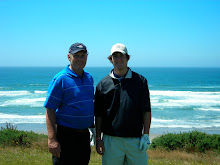
"I told Jack [Nicklaus] I loved national because it's so unpredictable. Every time I go there, there's something new to learn. What I like about it is the mystery. It's a course you're never going to figure out." -- Jim Urbina
Jim Urbina and Tom Doak started their careers by working for Pete Dye. Jim was the "dirt guy" whose experience and savvy on a bulldozer was the perfect complement to Tom's already extensive knowledge of classic courses and architectural principles. They teamed up in a partnership that gave them both a chance to learn from each other and push each other toward new ideas and concepts.
Jim was the field marshal for many courses, including Pacific Dunes. He was the guy who hired the labor force, drew up the work schedules, designed the drainage plans, coordinated the work of the subcontactors, worked with the course superintendent and the turf consultant, and, generally, made sure that all the moving parts worked together. During the construction at Pacific Dunes he put in 168 days on site, about three times as many as Tom, whose visits were spaced out so that he could review progress (often with Mike) and fine tune the work. At Old Macdonald, Jim put in just about the same number of days but this time -- at Mike's suggestion -- he shared the design billing with Tom.

During the building of Old Mac, Jim did a little of everything -- including, when needed, getting up on a Sand Pro to get the shaping exactly the way he wanted it. One of the best days I had during the construction of Old Mac was a day when I caught Jim and Ken doing a walk-around, with Jim pushing Ken, the superintendent, to give him "rough with soul."
I also go Jim to talk a little about the "power spots" on the property that he had come to know so well. For a practical guy, Jim aso has respect for intangible forces. He traces this back to his experience building Apache Stronghold,near the Superstition Mountains. A medicine man showed him where the spirits entered and exited the stronghold, and gave him a string of mojo beads that Jim has carried ever since. Those beads, and a copy of Macdonald's book -- the "red book" -- were his talismans during the work on Old Mac.
During the walk he showed me a couple of "power spots." One was on Old Mac No. 3, Sahara, where the drive has to clear a sand ridge that has a dead cedar silhouetted against the sky, the ghost tree. Jim was absolutely sure that this was a power spot; it had been confirmed for him when he almost got hit by lightning near the tree.

As Jim and Ken looked for places where some rough with soul might be introduced, they gave me a short seminar on the virtues of fescue. Old Mac is 100 per cent fescue, the first course at Bandon Dunes to be planted exclusively with fescue. From Ken's point of view, fescue is huge plus because it needs less water and chemicals than other kinds of grass.
From a design point of view, an all-fescue course makes for a playing surface where, says Jim, (everything just flows into everything else. You don't see lines and edges. The course isn't constantly giving you directions and about where to hit the ball or what kind of what you should play. It's all one playing field. The only way you'll know it's a green is because of the flag."
We walked some of the interior holes that day, where the fescue was just starting to sprout, and eventually made it up to the No. 14, one of the high points on the course. From there we could see just about every hole, plus some of Pacific Dunes, and Five Mile Point, and the shimmering Pacific. "When I look around now," Jim aid, I almost don't believe it. I think, Wow. We did all that. Tom, and Ken, and the whole crew -- we did that. We changed this place."















.jpg)










